How To Value Vintage Fashion Clothing
During the last two decades, the interest in vintage clothing and accessories has increased massively around the world. Many auction houses have established departments for vintage fashion clothing, and we've seen a great amount of new pre-owned boutiques pop up. What drags the most attention is, and has always been, vintage clothing from high-end brands. It's not always easy to value such items, but with the help of Value My Stuff's experts, it's possible to get a quick and accurate valuation.
Have you recently bought or inherited vintage fashion items and want to know their value? Value My Stuff offers valuations from leading experts within the field of vintage fashion clothing. Within 24 or 48 hours, our experts will value your items and submit a valuation certification. Find out the value of your items by clicking here!
What is Vintage Fashion Clothing?
The direct meaning of the word "vintage" is "of age", which defines that an item is old, and hence not new. A vintage dress could still be unworn, and so-called "new old stock", but if it's an older model, it's referred to as vintage. There are different definitions of how old something must be to be noted as vintage. The most common definition is that it shall be 25 to 100 years old. If it's more than 100 years old, then it's considered to be antique.
Fashion is a broad term that includes clothing and accessories of different kinds. In this article, we will only focus on clothing, not accessories. If you do, however, own fashion accessories – new or vintage – that you want to value, then Value My Stuff is the solution. Press here for more information.
The Market For Luxury Vintage Clothing
The main markets include Paris, London, New York, and Hong Kong. Some people buy luxury vintage clothing to wear the pieces, while others buy them as collector's items and have them displayed at home as a piece of art. The most sought-after clothing is from brands such as Chanel, Dior, Balenciaga, and Louis Vuitton.
Besides the brand name, the provenance of the item can make the value skyrocket. If something has been owned by a style icon such as Greta Garbo or Grace Kelly, the value is much higher than it otherwise would be. The same can be said about clothing that's been worn in movies, music videos, etc.
Read More: Princess Diana's Sheep Sweater Sold For $1.1 Million
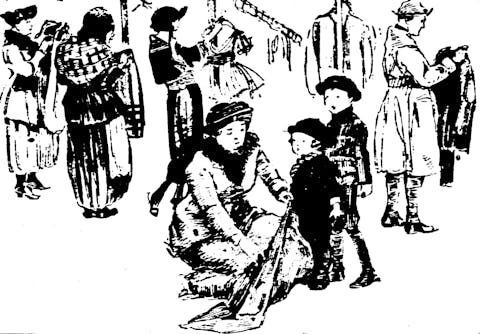
Sketch by Marguerite Martyn from 1920 of people looking over goods in a second-hand shop. (Public Domain)
The History of Fashion Clothing
The first humans on Earth had some kind of clothes to protect them from various weather. At that time, there wasn't a particular interest in that the clothes should look good, but rather that they had some function. When society began its structure and people got more power, clothes gradually became a status symbol. This can, for example, be seen in ancient Egyptian kings whose tombs have been excavated. Footwear is some of the earliest archaeological finds dating back to c. 5,000 BC.
Nowadays, pretty much every piece of clothing you find in stores is entirely made by machine. 50+ years ago, on the other hand, the majority was handmade. It was much more common to have bespoke or handmade clothes for a specific individual rather than off-the-rack clothing in different sizes. That changed drastically with new technology, better factories, product systems, etc. Today, the industry can be described as mass-produced fast fashion, meaning that you buy clothing that you'll use for a short amount of time. This means that the clothes are much more basic and have bad quality.
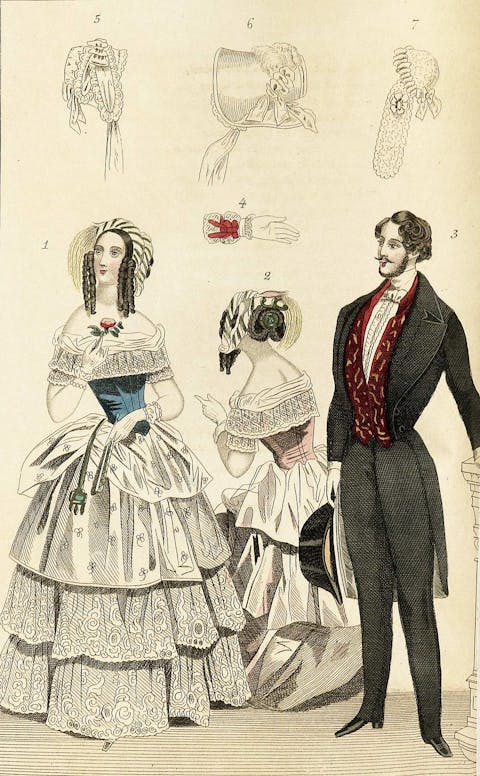
Victorian fashion sketch. (Public Domain)
Factors That Impact The Value of Vintage Fashion Clothing
It isn't easy to talk about valuation in general, as many factors can impact the value. Below are the most critical factors.
Brand: A Dior dress will always be more valuable than a Zara dress. People want high-end designer brands. They search for such brands online, and they ask for such brands in boutiques. There's also a status attached to high-end brands, which appeals to most buyers. Better brands also often mean better quality and rarity, two other factors listed below. Another detail is that high-end brands are generally in better condition since previous owners usually take good care of such items. That's why you rarely see a Hermès Birkin bag in lousy condition.
Condition: The better the quality, the higher the value. Very simple. The only exception to the rule is if the item has been owned and worn by famous people; in that case, we want to see that it has been worn, not in perfect condition. But if there's no special provenance, the condition is always desired to be as good as possible. One factor that impacts the condition is if there's been some work done on the item. A tailor may have fixed a broken part of a dress, etc. This is ordinarily negative for the value as the most desirable is to have the items untouched in their original appearance. On the other hand, a well-adjusted dress or pants may have a typically higher value than if it were torn down.
Rarity: The best would be if an item is a "piece unique", meaning it was only made in one example. That makes it extremely rare and, hence, more sought-after for buyers. If something is mass-produced, the value is often lower as the demand is closer to the supply.
Provenance: The provenance of an item is equivalent to the history of the item. Meaning who has owned it since it was made, where have it been, etc. Celebrity provenance can make the value 100 times more than it otherwise would be. Below, you can read about the most expensive vintage clothing ever sold, which features provenanced items.
Quality: Today's clothing is usually not of good quality as they are mass-produced to make prices as low as possible. That's why collectors appreciate clothing in good quality. This includes everything from fabric to the skillfulness of the designer. Even if clothing has no label, it can still be precious if the quality is top-notch.
Desirable: There are trends in all types of items, whether it's cars, art, or clothing. A trend can be very temporary and significantly affect the value. It can be a specific model, a particular color, or even a specific brand. On the contrary, a trend isn't necessarily positive, as it can be a boycott of a specific brand. That could be the case if a brand has gotten bad press recently.
The Seller: If you go to a yard sale, you may find high-end vintage Gucci clothing in top condition for a meager price. That same item could have a price tag 20 times as high if it were for sale by a fancy store in Paris or Manhattan. The asking price is usually higher if the seller is a reputable dealer. If it's an unknown person on eBay, then the price is generally lower. This is reasonable since the reputable dealer often has a guarantee, and you know what you get, while with an inexperienced seller, there are much higher risks. The location of the seller can also have an impact on the price, as some items are more desirable in certain countries.
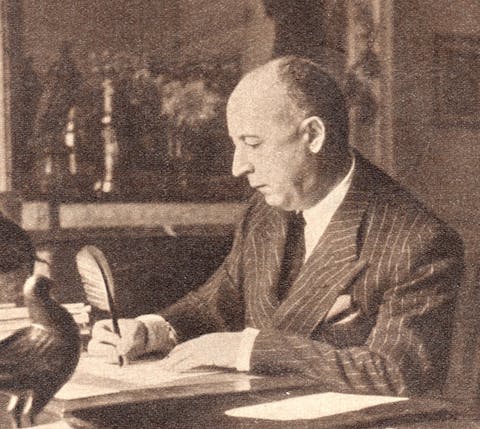
Christian Dior, 1905-1957. (Public Domain)
Vintage Fur Coat Valuations
It's undeniable that furs are back in fashion. An extravagant material, fur tends to be associated with high fashion and has been used on coats, jackets, mittens, skirts, and blouses alike. Vintage furs have been popular for fashion icons for decades – you only have to picture Marilyn Monroe, Marlene Dietrich, and Elizabeth Taylor to think of luxurious furs for beautiful women. Fur is a favorite among top designers like Ralph Lauren, Yves Saint Laurent, Calvin Klein, and Christian Dior, to name a few. Contemporary furs, although newly constructed and less worn, tend to be worth less than vintage furs or heirloom furs. Pre-owned furs continue to sell well on the market.
Today, artificial furs are so well crafted that it may be tough to recognize the difference between real or synthetic fibers, especially if no labels are giving away the composition. However, there are a few tricks to identify the kind of fur you have.
1. Check the fur at the base. Real furs usually are attached to the skin, while the fake ones have a fabric webbing. Some luxurious faux furs, though, can be attached to the leather lining, making it even more impossible to recognize.
2. The burn test (although you probably should not test that at the store). Clip the tips of the fur fibers off and set them on fire. If they start to melt, they are made of plastic and are therefore synthetic. Natural fibers will smell of burning hair, and clip off the tip of the fibers and set light to them. If they melt like plastic, it's fake. If they singe and smell of burning hair instead, prove the natural origins of your fur.
Just a few decades ago, a newly constructed natural fur coat would cost a small fortune and be a real statement piece in anyone's wardrobe. Today, for ethical reasons, people are much more fashion-conscious and usually pick artificial fur coats or real ones from the second-hand market. The main reason is not to support a harmful fur animal market but also fashion veganism. Because of this and a strict law regulating fur farms in many countries worldwide, the furs today are worth a fraction of what they once were. If you are looking to buy natural vintage fur, you can get even the most luxurious pieces on a second-hand market for just several hundred dollars. If you wish to sell furs that you, for example, inherited, the value will be determined based on several crucial factors.
Do you own a fur coat that you want to know the value of? Submit a valuation at Value My Stuff, and our fur expert will provide a valuation within 24 or 48 hours.
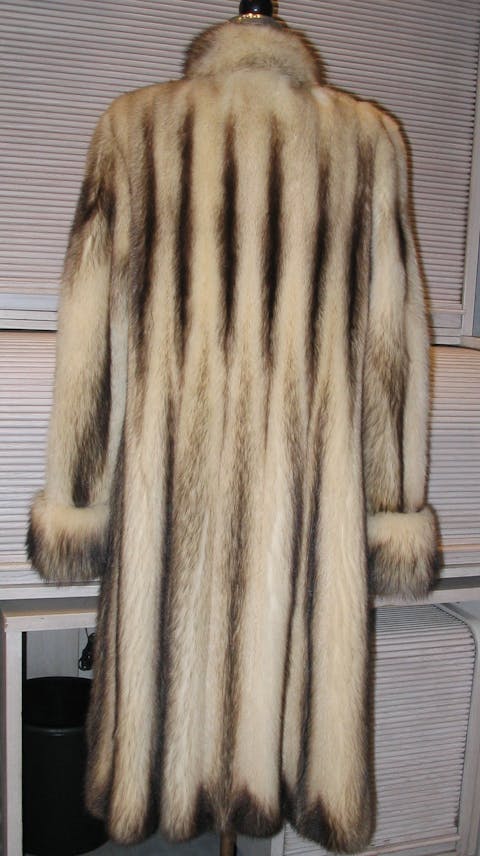
The back of a vintage fur coat. (Public Domain)
Vintage Chanel Clothing Valuations
As far as vintage clothing goes, Chanel is the number one brand by collectors.
Ask most women what the one garment they would not throw away in their annual spring clean, and it would most likely be the vintage Chanel couture that graces the farthest recess of their closet, possibly never to be worn, but one which should be valued by an expert prior to selling. Whether tweed, haute couture, formal wear, or Chanel accessories, our experts have access to the vintage fashion auction results that the House of Chanel's garments have achieved for decades.
By the 1920s, Coco Chanel was making waves in the world of fashion with her elegant, baggy trousers for women, androgynous designs, and black and white palettes. Already a well-respected designer, she had used wool from the Scottish Highlands, mainly the Shetland Isles. Chanel's connection with tweed began in 1924, however, when she commenced a relationship with the Duke of Westminster, Hugh Grosvenor. Although her French weavers were exasperated by the tendency of the Scottish wool to buckle, causing irregularities, Chanel loved the non-uniform nature of the fabric, and her love affair with tweed bloomed.
In the 50s and 60s, Chanel reintroduced the Chanel jacket in many pastel colors. Today, the classic fabric and design are still reworked by Karl Lagerfeld, the head of the Chanel fashion house. The Chanel jacket is not the only iconic item that continues to perform well at auction. Think of the little black dress, the cocktail dress, or the oversized oval sunglasses seen on Holly Go Lightly. Audrey Hepburn was the perfect Chanel model! Before Coco Chanel, wearing a black dress was reserved for mourning, and after her design hit Vogue in 1926, Chanel's dress became a symbol of a woman with taste.
Do you own vintage clothing by Chanel or any other top designers? Submit a valuation at Value My Stuff, and our fur expert will provide a valuation within 24 or 48 hours.
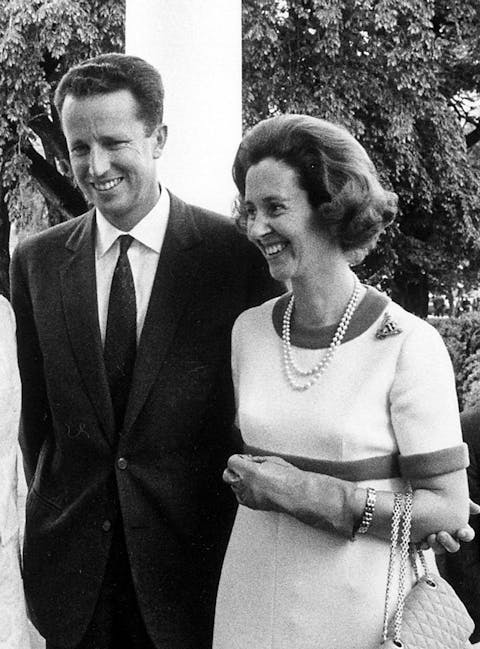
Belgian Queen Fabiola at the White House with a Chanel dress and a quilted leather Chanel handbag, 1969 (Public Domain)
The Most Expensive Vintage Fashion Clothing Ever Sold
Perhaps not surprisingly, the highest-paid items all have some special provenance. The most expensive item is Marilyn Monroe's "Happy Birthday, Mr. President" dress that she wore during John F. Kennedy's birthday celebration at Madison Square Garden in 1962. That dress was sold originally by Christie's in 1999 for $1.26 million and was later sold again in 2016 for $4.81 million, making it the most expensive vintage clothing ever sold.
Read More: Marilyn Monroe's Iconic "Happy Birthday, Mr. President" Dress
In the second place, we find yet another Marilyn Monroe dress. This time, the iconic "subway dress" from The Seven Year Itch Was hammered at $4.6 million. And thirdly is Audrey Hepburn's ascot dress from My Fair Lady, which sold for the impressive amount of $3.7 million.
Read More: Princess Leia's Iconic Dress Set to Sell for $2.5 Million
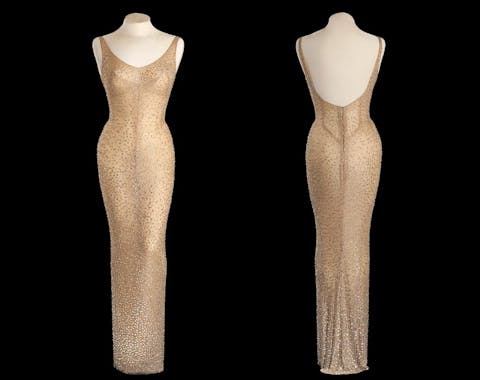
Marilyn Monroe’s “Happy Birthday, Mr. President” dress, 1962. (Julien’s Auctions)
How To Get Vintage Fashion Clothing Valued
Only a professional can provide you with a sure and particular range of value and an up-to-date price for your vintage clothing by using their experience and expertise to eliminate as much chance for misstep and error as possible. Luckily, here at Value My Stuff, experts in the field can provide professional valuation services so that you can take the necessary steps to discover how much your vintage clothing is worth today! Start Your Valuation Here!
Our Vintage Fashion Clothing Expert
For clothing, designers such as Chanel, Dior, Yves Saint Laurent, and other recognizable fashion houses immediately suggest quality and high value. Similarly, leather goods by designers such as Hermès and Louis Vuitton usually retain a timeless style and can be resold for high prices. Fur is a commodity that has been traded from early civilizations and, to this day, remains a status symbol for women and men worldwide. Commonly in vintage fashion, pieces can be passed down through generations and remain in families for many years; this means high-value items can very often become available to many people through inheritance or as gifts.

